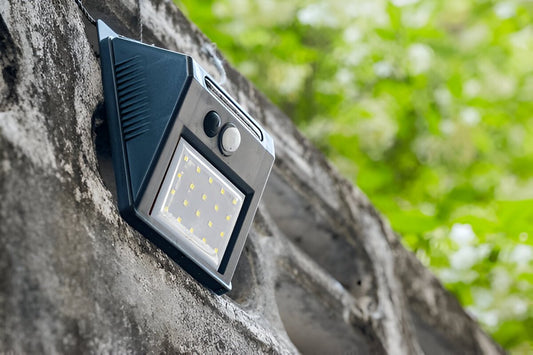
How Do Solar Wall Lights Work? A Simple Guide to Outdoor Lighting
A clever, energy-efficient approach to liven up outside areas are solar wall lights. Not only do they not require electricity, but they are powered only by sunshine, unlike traditional lights. This means no complex setup, no ongoing costs, and no wiring. Solar wall lights are now more adaptable than ever because of features like motion detectors, changeable brightness settings, and dusk-to-dawn operation.
Their durability is also another significant advantage. High-quality models have weather-resistant designs that withstand rain, snow, and extreme heat, ensuring year-round performance. Even in low-light situations, some can charge thanks to monocrystalline solar panels, which are more efficient than standard panels.
Solar lights provide a hassle-free and eco-friendly solution whether you want to light up your garden, driveway, patio, or entrance. In this guide, we’ll explain how solar wall lights work, their benefits, and installation tips, and answer common questions to help you choose the right one for your home.
What Is a Solar Wall Light?
A solar wall light is an outdoor light powered by solar energy. It has a built-in solar panel absorbs sunlight during the day, storing energy in a rechargeable battery. When the sun sets, the stored energy powers LED lights, automatically lighting the area.
Solar wall lights are durable and resistant to the elements, making them ideal for outdoor use in gardens, porches, patios, and garages. Some versions have motion detectors that activate the lights only when they sense activity, making them perfect for use as security lights.
How Does It Work?
Photovoltaic (PV) cells in solar wall lights convert sunlight into energy. The solar panel absorbs sunlight daily to create stored electricity within a built-in battery. A light sensor senses the difference when daylight withers and automatically turns on the LED lamps.
Solar wall lights provide dependable outdoor illumination and help to save energy costs since they do not run on power.
Benefits of Solar Wall Lights
Runs on Free Solar Power
Solar wall lights have among their main advantages the use of solar energy instead of electricity. This helps reduce electricity bills while providing reliable lighting for outdoor spaces. Once installed, they require little maintenance and can last for years.
Easy to Install
Solar wall lights, unlike wired lights, do not require complex wiring. Most models can be mounted with screws or adhesive tape, making them a quick and easy DIY upgrade for any home.
Eco-Friendly Lighting Solution
Solar wall lights are an excellent option for individuals seeking an eco-conscious alternative. Renewable energy helps lower carbon emissions. Hence, they are a sustainable substitute for traditional lighting.
Built-In Motion Sensors for Security
Motion sensors are used in many solar wall lights and turn on upon movement detection. This function improves house security by keeping outside areas well-lit and discouraging intruders.
Works Even During Blackouts
Since solar wall lights don't rely on electricity, they continue to work even during power failures. This ensures a steady light source, making them a reliable choice for outdoor lighting in any situation.
How to Install Solar Wall Lights
Step 1: Find a good spot.
Find a location with direct sunlight for at least 6-8 hours daily. Avoid placing the light under trees, roof overhangs, or shaded areas, as this can reduce charging efficiency.
Step 2: Mount the light
If your solar wall light comes with screws:
-
Mark the drill holes on the wall.
-
Use a drill to create holes.
-
Secure the light in place with screws and wall plugs.
For stick-on models:
-
Clean the surface properly.
-
Make sure it's dry before applying the adhesive backing.
-
Press the light firmly onto the surface.
Step 3: Turn it on & charge
If your light has a power switch, turn it ON before charging. Let it sit in direct sunlight for a full day to charge the battery fully.
Step 4: Test the light
Once it gets dark, check if the light turns on automatically. If it does, your solar wall light is ready to use!
Frequently Asked Questions
How long do solar wall lights last?
Solar wall lights can last many years with proper care. The LED bulbs typically last up to 50,000 hours (around 10 years). However, the rechargeable battery may need replacing every 2-3 years to keep the light working at its best. Clean the solar panel regularly to ensure it absorbs maximum sunlight to extend their lifespan.
Does weather affect solar wall lights?
Yes, weather can impact how well solar wall lights charge. Cloudy or rainy days may reduce sunlight, affecting battery performance. Winter months with shorter daylight hours can also cause dimmer lighting at night. However, most high-quality solar wall lights are weatherproof and built to withstand rain, snow, and heat, so they continue working in most conditions.
What are the best solar wall lights?
The best solar wall lights depend on your needs. For security, choose motion sensor lights with bright LEDs. For decoration, go for warm white or colored LED models. Pick lights with efficient solar panels and durable batteries if you want long-lasting performance. Look for weatherproof models with high brightness (lumens) and reliable battery life to get the best value.
Conclusion
Solar wall lights are a cost-effective, easy-to-install, and environmentally friendly way to light outdoor spaces. They charge daily and automatically turn on at night, providing hassle-free lighting. They are a great alternative to wired outdoor lighting with minimal maintenance and no electricity costs.
When choosing a solar wall light, consider brightness, battery life, and weather resistance to ensure the best performance. Whether for security, decoration, or convenience, solar wall lights are an excellent choice for any home.
Are solar wall lights worth it? Check out our blog here to learn more before making your decision!